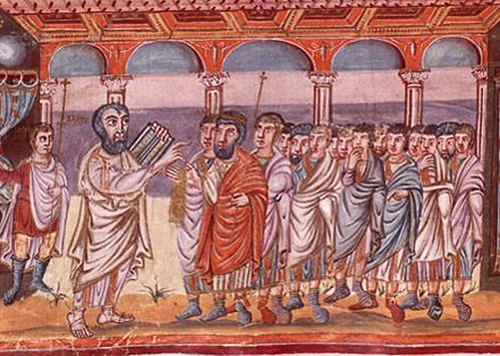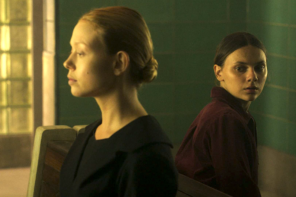What inspired you to write Dark Mirror?
The idea came to me nine years ago, when I was on academic leave in Tel Aviv. I took my leave in Israel largely for family reasons, not for research purposes. I had recently finished a book about a set of anti-Jewish manuscripts, and was starting a project that had nothing to do with Jewish history, examining what medieval Christian preachers said about art and physical vision. Frankly, I was a bit tired of dealing with dark subjects, and thought it would be soothing to read Latin sermons. But Israel is not a very good place to go to get away from Jewish topics! I was asked to give several talks during the year, and of course the people who invited me were more interested in Jewish history than in Latin sermons. As I tried to come up with something new to say about Jews in art, I realized that the sermons I had been reading explained a great deal. Five hundred years of dizzyingly dense imagery suddenly began to make sense. I shared my ideas with a very good friend – the friend to whom I dedicated Dark Mirror – and he encouraged me to write the book.
What’s the most important take-home message for readers?
That medieval pictures of Jews are not straightforward images of what Jews looked like, or even how Christians regarded Jews. Rather, they reflect Christian thinking about their own culture, faith, and morals. So, for example, artworks that show God hiding his face from Jews were designed to teach Christians that they should strive to ‘see’ God with their hearts, not with their eyes. But the effect of images didn’t stop there. Pictures have their own power – they generate new responses and give their viewers new ideas. Medieval images of Jews changed the way people viewed Jews, and so helped plant the seeds of western anti-Semitism.
I suppose if I were to boil it down to one message (as you asked!) it would be that pictures are a central actor in Jewish (and Christian) history.
Is there anything you had to leave out?
Lots! Many aspects of individual artworks, for example. In my first book I discussed two (admittedly large) manuscripts made in Paris in a single decade, and was able to delve deeply into their patronage, context, sources, uses, etc. In Dark Mirror I cover well over a hundred images made in seven countries over the course of 500 years. It inevitably feels like I’m skimming over a great deal, far too quickly. But it was important to me to tell a big story and to tell it as clearly as I could.
What are some of the biggest misconceptions about your topic?
That images of Jews have always been the same and have always been hostile; that Christian hatred of Jews was constant, automatic, and inevitable. This is not to downplay the very real and disturbing anti-Jewish animosity and, increasingly, violence that plagued medieval Christendom. But it does mean that they have to be explained rather than taken for granted. Anti-Jewish polemic and violence were the result of choices, and so even more ethically troubling.
Did you have a specific audience in mind when writing?
Anyone interested in religion, history, art, ethnic relations, or visual stereotyping. Although I certainly hope my academic colleagues will read and learn from the book, I wanted it to be accessible to general readers. I care very deeply about the subject – it’s too important to keep to a specialist audience only.
Are you hoping to just inform readers? Entertain them? Piss them off?
I expect to surprise some people; I certainly hope to interest them! And also to make them re-think some received wisdom. I have no desire to upset anyone, but given the sensitivity of the topic, it may well happen, and I will have to accept that.
What alternative title would you give the book?
A jokey answer would be Jewiness Per Square Inch, after a segment from “The Daily Show” in which Jon Stewart rates photographs of prominent figures according to their relative “Jewy” quotient. Like all good satire, this silliness harbors an important point – that stereotypes are artificial amalgamations that only very imperfectly approximate reality, and yet powerfully shape our perception of reality.
More seriously, for years I had a different working subtitle: “Jews, Vision, and Witness in Medieval Christian Art.” But my brilliant editor thought that the subtitle should be more straightforward and comprehensible, and of course she’s right.
How do you feel about the cover?
I love it! The image is from a beautiful manuscript, it encapsulates an important aspect of the book, and the design is lovely. And who doesn’t love a hairy naked ape-man?
Is there a book out there you wish you had written? Which one? Why?
I’m a little uncomfortable with that question; wishing you had written someone else’s book seems like stealing, somehow. But I have always wanted to write fiction, so Wolf Hall comes to mind. It recreates the feeling and cares of the past better than any work of history I’ve ever read. Another favorite is Peter Brown’s World of Late Antiquity — a work of history so fluid and evocative that it reads like a novel.
What’s your next book?
I have returned to that study of preaching, art, and vision. I still find Latin sermons soothing! But even though the book is not about Jews, I expect Jews will turn up. When medieval Christians thought about the material world and beautiful, luxurious things they tended to think about Jews. I am also thinking of writing a memoir about a year I spent teaching in a Christian international high school in Jerusalem. It was during the first intifada, when West Bank schools were closed, so in addition to the international students (children of clergy, diplomats, and United Nations employees), there were many Palestinian students. It was a fascinating microcosm of Jewish-Christian-Muslim relations. These young people faced unthinkable challenges, preparing for college or careers and learning to be adults in one of the most contested cities in the world. I felt for them, and loved them!





